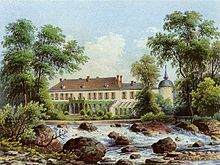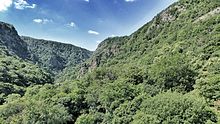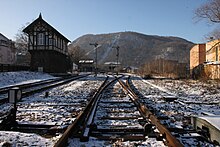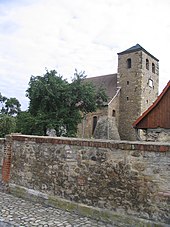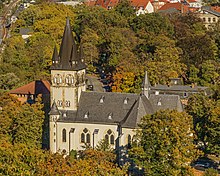Thale
| coat of arms | Germany map | |
|---|---|---|

|
Coordinates: 51 ° 45 ' N , 11 ° 3' E |
|
| Basic data | ||
| State : | Saxony-Anhalt | |
| County : | resin | |
| Height : | 156 m above sea level NHN | |
| Area : | 137.64 km 2 | |
| Residents: | 17,247 (Dec. 31, 2019) | |
| Population density : | 125 inhabitants per km 2 | |
| Postal code : | 06502 | |
| Primaries : | 03947, 03946, 039456, 039459, 039485, 039487, 039488 | |
| License plate : | HZ, HBS, QLB, WR | |
| Community key : | 15 0 85 330 | |
| LOCODE : | DE THA | |
| NUTS : | DEE09 | |
City administration address : |
Rathausplatz 1 06502 Thale |
|
| Website : | ||
| Mayor : | Thomas Balcerowski ( CDU ) | |
| Location of the city of Thale in the Harz district | ||
Thale is a town in the Harz district of Saxony-Anhalt and is located on the northeastern edge of the Harz Mountains . The Bodetal begins above Thale . Thale has been a state-approved resort since 2004 .
geography
climate
|
Average monthly temperatures and rainfall for Thale
Source: climate-data.org
|
|||||||||||||||||||||||||||||||||||||||||||||||||||||||||||||||||||||||||||||||||||||||||||||||||||||||||||||||||||||||||||||||||||||||||||||||||||||||||||||||||||||
Neighboring communities
Thale is a town in the Harz district and borders on six towns and municipalities (clockwise, starting in the northwest): Blankenburg (Harz) , Halberstadt , Harsleben , Quedlinburg , Harzgerode and Oberharz am Brocken .
history
The Thale settlement was probably built at the beginning of the 10th century. It was mentioned for the first time in 936 in connection with the neighboring Wendhusen monastery , which was founded as a canonical monastery before 840 as one of the first monasteries on Saxon soil. The monastery came under the protection of the monastery in Quedlinburg . The village was called Dat Dorp to dem Dale from 1231 (whose sex was given in Latinized form, from 1288 with the place name de valle , from 1303 by Thale ). The monastery was destroyed in 1525 during the Peasants' War.


An ironworks can be found in Thale since 1445 . After being abandoned in the Thirty Years War, it was rebuilt in 1648 as the Berghaus zum Wilden Mann , but completely destroyed in 1670. In 1686 a small hammer forge was established , from which a new ironworks later developed, which was particularly favored by the proximity to ore deposits and wood. It existed until 1714. In 1740 another company was opened. The ironworks was briefly owned by Frederick the Great . In 1831 the first wrought-iron wagon axle, which had been built in Germany to date, was manufactured here. In 1835 the oldest sheet metal enamelling plant in Europe was founded in Thale. After the city was connected to the railroad in the direction of Berlin in 1862 , the place and the number of workers grew: While Eisenhüttenwerk Thale AG employed only 350 people in 1872, it was 4,400 in 1905. Above all, enamel production contributed to Thale's international reputation After all, at peak times 10% of global production came from the largest European enamel factory. In 1910 Karl Liebknecht , Rosa Luxemburg and Clara Zetkin spoke to Thalens workers.
During the First World War, the German steel helmets (M1916) were produced in the ironworks from 1916 , the prototype of which had been developed there in 1915. From 1934, the plant had a monopoly on steel helmet production. During the GDR era, the plant was converted into VEB Eisen- und Hüttenwerke Thale. For the 300th anniversary in 1986, the Thale Hüttenmuseum was founded at the site of the plant.
The long-term investment backlog almost led to the end of the traditional company after the fall of the Wall. It was finally privatized in 1993 when it was sold to the former Prime Minister of Lower Saxony Ernst Albrecht and the businessman Hans Henry Lamotte. However, there was no sustainable further development during this time. It was not until the takeover by the Schunk Group from Gießen (1997) that the different company areas were re-invested, especially enamel processing.
Tourism has flourished since the 19th century in connection with the water from the Hubertus spring , which was later classified as containing radon , on Hubertus Island , which was opened up in 1836. Various writers such as Heinrich Heine ( Die Harzreise ) and Theodor Fontane visited the place and especially the Bodetal. In addition, Berlin tourists in particular enjoyed the Thalens summer retreat. This was made possible by the connection of Thale to the railway from Wegeleben in 1862 . In 1909 a branch line from Blankenburg (Harz) followed .
In 1922 the place received city rights .
After evacuation by remaining German troops on April 20, 1945, Thale was occupied by US troops largely without a fight . The iron and steel works also fell into their hands undamaged. At the Thale cemetery there is a memorial stone for 21 unknown Wehrmacht soldiers. In the Warnstedt cemetery, a gravestone shows 20 German soldiers buried there, two of whom are “unknown”.
From the beginning of July 1945 Thale also became part of the Soviet occupation zone and from 1949 of the GDR.
From June 12th to 14th, 2009, Thale was the venue for the Saxony-Anhalt Day under the motto Thale legendary , which attracted around 200,000 visitors.
Incorporations
Warnstedt was incorporated in 2003. In 2009 a total of seven municipalities were incorporated at four different times. Westerhausen was added in 2010. Allrode became a district of Thale in 2011. The incorporation of Friedrichsbrunn and Stecklenberg was controversial, as the neighboring communities of Gernrode , Bad Suderode and Rieder had sought to form a unified community with them. The original incorporation on September 29, 2009 was thus postponed.
|
|
population
Development of the population (from 1995 December 31st) :
|
|
|
politics
City council
The local elections on May 26, 2019 led to the following result with a turnout of 53.2%:
| Party / list | Share of votes | +/-% p | Seats | +/- |
| CDU | 51.4% | + 2.1 | 15th | + 1 |
| AfD | 13.9% | + 13.9 | 1 | + 1 |
| The left | 12.5% | - 2.2 | 3 | - 1 |
| SPD | 6.1% | - 2.3 | 2 | ± 0 |
| Citizen List | 11.0% | - | 3 | - 3 |
| FWG Westerhausen | 5.0% | - | 1 | - 1 |
mayor
- 1901–1932: Otto Schönermark (1865–1947), first mayor
- 1932–1936: Herrmann Friedrich Richter, Mayor
- 1923–1935: Willy August, Mayor
- 1935–1941: Werner Günter Hellmuth Meyer-Estner, first mayor
………
- 1990–1994: Erich Schweidler
- 1994–2001: Hans-Michael Maertens (CDU)
- since 2001: Thomas Balcerowski (CDU)
coat of arms
Valid coat of arms
The coat of arms was approved on July 11, 1996 by the Magdeburg Regional Council.
Blazon : "In silver, a tinned blue tower with a pointed, gold-knobbed red roof and an open gate, covered with a silver shield above the gate, in which a red witch riding a broomstick."
The tower represents Thale Castle, mentioned in 1340, which was built in the 10th century to protect the Wendhusen monastery and destroyed around 1365. The witch in the silver shield stands for the generally understandable symbol of the witches dance place. The development of the place is closely connected with the Hexentanzplatz and the Bodetal. The mountain already had a prehistoric meaning and was a wall of the Harz inhabitants against the enemy armies in the Thirty Years' War. The open gate is intended to indicate the hospitality of the place.
Coat of arms during the National Socialist era
The coat of arms was awarded on May 19, 1937 by the Upper President of the Province of Saxony and designed by Magdeburg State Archives Councilor Otto Korn .
Blazon: "In silver, a wide blue gate tower with battlements and a red gable roof, covered with a shield with a square cut of silver and red."
The applied shield is the coat of arms of the noble family von Thale (van deme Dale, de Valle), which died out around 1650 and whose ancestral seat was Thale. The tower points to the castle mentioned in 1340.
Coat of arms in GDR times
The coat of arms was confirmed by the city council in 1953.
Blazon: "In silver, a tinned blue tower with a pointed, knocked red roof and open gate, above the gate a silver shield: obliquely left divided by a red cogwheel, above an upright black hammer, below a green fir tree breaking out of the edge of the shield."
The tower probably refers to a previous castle of the Lords of the Dale. The content of the sign symbolizes the local iron industry on the one hand, and the Harz landscape on the other.
Town twinning
It has been twinned with Seesen ( Lower Saxony ) on the northwestern edge of the Harz Mountains since 1990 and with the French city of Juvisy-sur-Orge, 18 km from Paris, and the Nigerian city of Tillabéri, northwest of the Niger River, since 1998 .
Culture and sights
Museums
- Thale Hut Museum
- Wendhusen Abbey with a special topic canonical pens
- Walpurgis Hall
- Obscurum Thale. Museum of Witchcraft and Dark Forces.
- GDR Museum Thale
- Local history museum Westerhausen
Buildings
- The Wotan monument by the ash tree at the town hall, a statue for Heimdall , and Sleipnir on the Germanic Mythenweg
- The former Wendhusen monastery from Carolingian times
- The Hotel Zehnpfund , built in 1863, was formerly the largest summer hotel in Germany
- The Evangelical St. Petri Church, completed in 1906
- The Catholic Herz-Jesu-Kirche was established in 1910 and 1911
- In 2017, a pedestrian suspension bridge and megazipline were opened over the Wendefurth reservoir , which connects the Upper Harz with the Thalenser side of the reservoir.
- The windmill in the Warnstedt district, visible from afar
The Villa Rosenburg, built in 1848, and the Berghotel Rosstrappe are also under monument protection . The architectural monuments of Thales are registered in the Thalenser monument register.
Other cultural institutions
|
|

Regular events and events
- The original Walpurgis Night on the Hexentanzplatz
- Street festival on the occasion of Walpurgis Night (April 30th)
- The place is one of the eight places in which the tradition of the finch maneuver in the Harz , which has been recognized as an intangible world cultural heritage since 2014, is still cultivated.
Natural monuments
From Thale you have access to the Bodetal . The Bodetal is dominated by the Hexentanzplatz , which can be reached with the Bodetal cable car , and the Roßtrappe , to which a chair lift leads.
In the districts of Neinstedt , Weddersleben and Warnstedt lies the Teufelsmauer , which is one of the oldest nature reserves in Germany.
From Thale, the Harzer Hexenstieg is an almost 100 km long hiking trail across the Harz to Osterode , passing various sights such as the Brocken , Torfhaus , Dammgraben and the Oberharzer ponds .
societies
There are several sports clubs in the Thale region. The club with the largest number of members is SV Stahl Thale with the departments football, handball, tennis, boxing, volleyball, disabled sports, dancing, basketball, cross-country skiing and fistball.
Economy and Infrastructure
Industry
Important industrial companies in Thale today are the company Schunk Sintermetalltechnik , the company Thaletec GmbH , ElringKlinger AG, Linamar Valvetrain GmbH as well as the Maschinenfabrik Thale (MFT) and the manufacturer of special automation devices Mertik Maxitrol , but also the company Corodur Wear Protection GmbH.
Educational institutions
In Thale there is the European high school Richard von Weizsäcker , the secondary school THALE / NORD and two primary schools: the primary school Geschwister Scholl and the primary school Auf den Höhen . The Free Waldorf School Harzvorland and the Free All-Day School Quedlinburg eV (in Neinstedt , a district of Thale) exist at other school facilities . Vocational training centers are the Education and Technology Center (BTZ) and the German Employee Academy (DAA). The PowderMetallurgical Competence Center (PMC) in Thale acts as a start-up center for companies.
traffic
Thale Hauptbahnhof is the end of the Magdeburg – Thale railway line ; there it ends in a terminal station . Thale has two other train stations: Thale Musestieg and Neinstedt .
The former Blankenburg – Quedlinburg railway line (via Thale Bodetal) (1907–1963 in passenger traffic) has now been completely dismantled. Thale can be reached with the PlusBus 250 . Thale is also a traffic node in the bus network of the Harz transport company .
Thale has a direct connection to the federal motorway 36 ( Braunschweig - Bernburg (Saale) ). Via this there is a connection to the A14 to the east and to the A2, A7 and A39 to the west.
- Next airfield : 18 km ( Ballenstedt airfield )
- next international airport: approx. 100 km ( Leipzig / Halle )
- Next inland port: approx. 65 km ( Magdeburg port )
Religions
The Protestant parish of Thale includes the churches of St. Andreas from the 18th century in the Unterdorf and St. Petri from 1906 in the Friedenspark. Their parishes belong to the Evangelical Church in Central Germany .
The Catholic parish of the Sacred Heart has the same name, built around 1910 Church at the Walter Rathenau Street, since 2010 it belongs to the parish of St. Mathilde Quedlinburg.
The New Apostolic congregation in Thale was merged with the congregation in Blankenburg in 2006 , and since then there have been no New Apostolic divine services in Thale.
Personalities
literature
- Ute Fuhrmann, Rainer Vogt: The stones at Hexentanzplatz: Thale and surroundings - rediscover a Harz landscape. (City stories series 1). 2nd Edition. Dössel (Saalkreis) 2007, ISBN 978-3-89923-116-8 .
- Cilda Schrader: Thale 80 years ago: a contribution to the 80th anniversary of the founding of Thales . In: Quedlinburger Annalen, local history yearbook for the city and region of Quedlinburg. 5 (2002), ISSN 1436-7432 , pp. 84-89.
- Manfred Mittelstaedt: Thale am Harz. (The archive images series). Erfurt 2004, ISBN 3-89702-683-X .
- Berent Schwineköper (Hrsg.): Handbook of the historical sites of Germany . Volume 11: Province of Saxony Anhalt (= Kröner's pocket edition . Volume 314). 2nd, revised and expanded edition. Kröner, Stuttgart 1987, ISBN 3-520-31402-9 , pp. 462-464.
Web links
- Official website
- Link catalog on Thale at curlie.org (formerly DMOZ )
- Comprehensive overview of the business location Thale ( Memento from November 20, 2007 in the Internet Archive )
Individual evidence
- ↑ State Statistical Office Saxony-Anhalt, population of the municipalities - as of December 31, 2019 (PDF) (update) ( help ).
- ↑ Archived copy ( memento of the original from September 29, 2015 in the Internet Archive ) Info: The archive link was inserted automatically and has not yet been checked. Please check the original and archive link according to the instructions and then remove this notice. : Saxony-Anhalt Wiki: Thale
- ↑ State Statistical Office of Saxony-Anhalt ( Memento of the original from September 28, 2011 in the Internet Archive ) Info: The archive link was inserted automatically and has not yet been checked. Please check the original and archive link according to the instructions and then remove this notice. on the territorial changes 1994–2007
- ^ StBA: Changes in the municipalities in Germany, see 2003
- ↑ StBA: Area changes on 01/01/2009
- ↑ StBA: Area changes from January 2nd to December 31st, 2009
- ↑ StBA: Area changes from January 01 to December 31, 2010
- ↑ StBA: Area changes from January 1st to December 31st, 2011
- ^ Law on the incorporation of the city of Gernrode and the municipalities of Bad Suderode and Rieder into the city of Quedlinburg , draft of July 11, 2013
- ^ Database census 2011, Thale, Stadt, age + gender
- ↑ Contains the data up to 1939
- ^ Election City Council 2019 Thale
- ↑ State Statistical Office Saxony-Anhalt, municipal elections 2019 - City of Thale , accessed on October 15, 2019
- ↑ Entry at the State Archive of Saxony-Anhalt
- ↑ Uwe Kraus: How the "witches" really were , in: Neues Deutschland from October 26, 2018, p. 14
- ↑ http://www.waldorfschule-harzvorland.de/ October 13, 2016
- ↑ http://www.freieganztagsschule.de/ October 13, 2016
- ↑ Cf. Dirk Endisch: The main line Halberstadt-Thale . Korntal-Münchingen 2006, ISBN 3-936893-34-9 .



